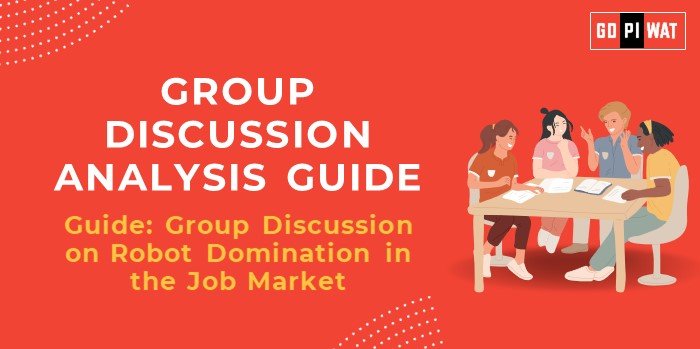🤖 Group Discussion Analysis Guide
🌐 Introduction to Robot Domination in the Job Market
The integration of robots and artificial intelligence (AI) into various industries is reshaping the global job market, prompting discussions about the future of employment. While automation offers significant productivity gains, it also raises concerns about job displacement and the evolving nature of work.
📊 Quick Facts and Key Statistics
- 🌍 Global Industrial Robot Usage: As of 2023, approximately 4.28 million industrial robots are operational worldwide, marking a 10% increase from the previous year. Source: IFR
- 📈 Annual Robot Installations: In 2023, 541,302 industrial robots were installed globally, the second-highest annual figure on record. Source: IFR
- 🔍 AI’s Impact on Jobs: The World Economic Forum’s Future of Jobs Report 2023 predicts that by 2027, 69 million new jobs will be created, while 83 million will be eliminated, resulting in a net decrease of 14 million jobs. Source: World Economic Forum
- ⚙️ Automation Potential: Approximately 42% of business tasks are expected to be automated by 2027, highlighting the significant impact of AI and robotics on the workforce. Source: News.com.au
🔗 Stakeholders and Their Roles
- 🏛️ Governments: Develop policies and regulations to manage the transition towards automation, ensuring workforce readiness and addressing potential unemployment.
- 💻 Technology Companies: Drive innovation in AI and robotics, influencing the pace and direction of automation across industries.
- 🎓 Educational Institutions: Adapt curricula to equip students with skills relevant to an automated future, emphasizing STEM education and digital literacy.
- 👩💼 Workforce: Engage in continuous learning and upskilling to remain competitive in a rapidly changing job market.
🏆 Achievements and Challenges
✨ Achievements
- 📈 Increased Productivity: Automation has led to significant efficiency gains in manufacturing and logistics, reducing costs and improving output.
- 🛠️ Job Creation in Tech Sectors: The rise of AI has spurred demand for roles such as data analysts, AI specialists, and cybersecurity experts.
- 🦺 Enhanced Safety: Robots perform hazardous tasks, reducing workplace injuries and improving overall safety standards.
⚠️ Challenges
- 🚧 Job Displacement: Automation threatens roles in sectors like manufacturing, retail, and transportation, potentially leading to unemployment.
- 📚 Skill Gaps: There’s a growing need for upskilling and reskilling programs to prepare workers for new roles created by automation.
- ⚖️ Economic Inequality: The benefits of automation may not be evenly distributed, potentially widening the gap between high-skill and low-skill workers.
🌍 Global Comparisons
- 🇯🇵 Japan: Leads in robot density with 399 robots per 10,000 employees, reflecting a high level of automation in manufacturing.
- 🇩🇪 Germany: Emphasizes vocational training and apprenticeships to integrate automation while maintaining low unemployment rates.
📦 Case Studies
Amazon’s Fulfillment Centers: Utilize robots for tasks like sorting and packaging, increasing efficiency but raising concerns about worker displacement.
🗣️ Structured Arguments for Discussion
- Supporting Stance: “Automation enhances productivity and economic growth, creating new opportunities in tech-driven sectors.”
- Opposing Stance: “The rapid adoption of robots leads to significant job losses, particularly in low-skill occupations, exacerbating unemployment.”
- Balanced Perspective: “While automation displaces certain jobs, it also creates new roles and necessitates a focus on reskilling and education to adapt to the evolving job market.”
🧭 Effective Discussion Approaches
- Opening Approaches:
- Present recent statistics on automation’s impact on employment to set the context.
- Share a real-world example, such as the automation strategies employed by Amazon, to illustrate the topic’s relevance.
- Counter-Argument Handling:
- Acknowledge the benefits of automation in terms of efficiency and safety.
- Highlight the importance of policies and education systems that support workforce adaptation to technological changes.
📈 Strategic Analysis of Strengths and Weaknesses
Strengths
- 📈 Enhanced productivity and efficiency across industries.
- 💸 Reduction in operational costs and human error.
- 🦺 Ability to perform hazardous tasks, improving workplace safety.
Weaknesses
- ⚠️ Potential for significant job displacement in certain sectors.
- 💰 High initial investment costs for implementing automation.
- 🔒 Dependence on technology may lead to vulnerabilities, such as cybersecurity risks.
Opportunities
- 💼 Development of new industries and job roles centered around AI and robotics.
- 📈 Potential for economic growth through increased efficiency and innovation.
- 🔄 Improvement in quality of life by automating mundane and repetitive tasks.
Threats
- ⚖️ Widening economic inequality due to uneven distribution of automation benefits.
- 🚨 Social unrest stemming from job losses and economic displacement.
- ⚖️ Ethical concerns regarding the use of AI and robots in decision-making processes.
🎓 Connecting with B-School Applications
- Real-World Applications:
- Exploring the role of automation in supply chain management and operations.
- Analyzing the impact of AI on financial modeling and risk assessment.
- Developing strategies for managing organizational change in the face of technological advancements.
- Sample Interview Questions:
- “How can businesses balance the benefits of automation with the need to maintain employment levels?”
- “What strategies should companies adopt to reskill their workforce in response to increasing automation?”
- “How does the integration of AI and robotics influence ethical decision-making in business?”
- Insights for B-School Students:
- Understanding the importance of adaptability and continuous learning in a rapidly changing job market.
- Recognizing the need for ethical considerations in the deployment of AI and automation technologies.


